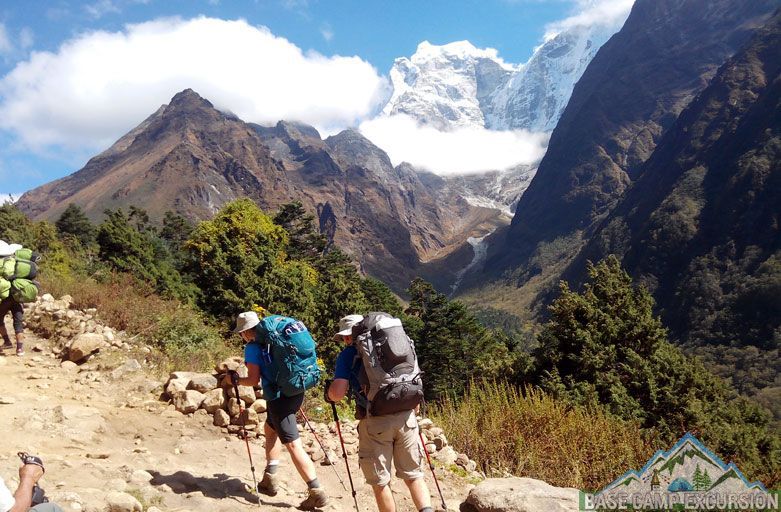Trekking to Everest Base Camp Trek in June presents both challenges and unique experiences amidst the backdrop of Nepal’s monsoon season. This time of year brings warmer temperatures to the Everest region, ranging from approximately 15°C to 20°C during the day at lower altitudes. However, as you ascend, temperatures can drop, especially at night, necessitating layered clothing for comfort.
The onset of the monsoon brings occasional rain showers, typically in the afternoon or evening. While these showers can make the trails muddy and slippery, they also contribute to the region’s lush greenery and vibrant blooms of rhododendrons along the route. Despite the rain, trekkers can still enjoy breathtaking views of the surrounding landscapes, although cloud cover may obscure mountain vistas periodically.
June is considered the off-season for trekking to Everest Base Camp, resulting in fewer crowds on the trails and more available accommodation options in tea houses and lodges. This quieter environment allows for a more peaceful trekking experience, with opportunities to interact more closely with local communities and enjoy the serenity of the Himalayan wilderness.
Despite these advantages, trekking in June does come with its challenges. The unpredictable weather can be a significant factor, requiring trekkers to be prepared with waterproof gear and to exercise caution on potentially slippery trails. Patience is essential, as weather conditions can change rapidly, impacting visibility and trekking schedules.
Overall, trekking to Everest Base Camp in June offers a unique and quieter perspective of this iconic trekking destination. With adequate preparation and a flexible attitude towards weather conditions, trekkers can still enjoy a memorable and rewarding journey amidst the awe-inspiring landscapes of the Everest region.
Everest Base Camp Trek Highlights in June
June brings a unique charm to the EBC Trek with lush green landscapes and blooming rhododendrons along the trail. Despite occasional rain showers, trekkers can still enjoy stunning views of the Himalayas when the skies clear. The quieter trails allow for a more intimate experience with local culture and fewer crowds at tea houses and lodges.
Weather Conditions in June
June marks the beginning of the monsoon season in Nepal, bringing warmer temperatures (15°C to 20°C) during the day and occasional rain showers, typically in the afternoons or evenings. Nights can be chilly, especially at higher altitudes. Trekkers should prepare for variable weather conditions, including cloudy skies that may obscure mountain views but also contribute to the region’s lush greenery.
Difficulty Level of the Trek in June
The Everest Base Camp trek in June presents moderate difficulty. While warmer temperatures and occasional rain showers can make the trail muddy and slippery, fewer trekkers mean quieter trails and more available accommodation. Trekkers should be prepared for the physical challenges of ascending to high altitudes and be mindful of changing weather conditions.
Altitude Sickness
Altitude sickness remains a concern on the Everest Base Camp trek, regardless of the time of year. In June, trekkers should acclimatize properly, stay hydrated, and ascend gradually to minimize the risk of altitude-related illnesses. It’s crucial to recognize symptoms early and descend if necessary to lower altitudes for proper rest and recovery.
Rugged and Remote Trails
The Everest Base Camp trek in June offers trekkers a rugged and remote experience through the Himalayan terrain. The trails wind through challenging landscapes, including rocky paths, steep ascents, and occasional river crossings. This ruggedness adds to the adventure and rewards trekkers with stunning vistas of snow-capped peaks and serene alpine environments.
Long Duration Trek
The Everest Base Camp trek typically spans about 12-14 days, making it a longer duration trek suitable for those seeking an immersive Himalayan adventure. This extended journey allows trekkers to gradually acclimatize to higher altitudes, explore remote villages, and soak in the diverse cultural and natural beauty of the Everest region.
Accommodations
Accommodations along the Everest Base Camp trek in June primarily consist of tea houses and lodges operated by local communities. These establishments offer basic yet comfortable amenities such as twin-sharing rooms, hot showers (for a fee), and hearty meals ranging from traditional Nepali dal bhat to international dishes. Tea houses provide a cozy retreat after a day of trekking, fostering a sense of camaraderie among fellow trekkers.
Why Take This Everest Base Camp Trek in June?
Trekking to Everest Base Camp in June offers a distinct adventure amidst Nepal’s monsoon season. The quieter trails allow for a more intimate experience with nature and local culture, away from the peak tourist season. Despite occasional rain showers, trekkers can still enjoy breathtaking views and lush landscapes. June also presents an opportunity to witness blooming rhododendrons and vibrant greenery along the trail, adding to the trek’s natural beauty. Additionally, accommodations are more readily available, providing flexibility and comfort during the journey. Overall, June offers a unique perspective of the Everest region, combining adventure, tranquility, and natural splendor for those seeking a memorable trekking experience.
Everest Base Camp Weather and Temperature in June
June marks the beginning of the monsoon season in Nepal, affecting the weather conditions on the Everest Base Camp trek. Daytime temperatures at lower altitudes range from 15°C to 20°C, while higher altitudes may experience cooler temperatures, especially at night. Rain showers are common, typically occurring in the afternoons or evenings, which can make trails muddy and slippery. Cloud cover may intermittently obscure mountain views, although clear skies offer stunning vistas of Everest and surrounding peaks.
Advantages of Trekking to Everest Base Camp in June
Trekking to Everest Base Camp Trekking in June offers several advantages. The quieter trails provide a more peaceful and intimate trekking experience, away from the peak tourist season. Accommodations in tea houses and lodges are more readily available, allowing for greater flexibility and choice. The lush green landscapes and blooming rhododendrons add to the scenic beauty along the trail, despite occasional rain showers. Trekkers can also enjoy interacting more closely with local communities due to fewer crowds.
Things that may be of concern while trekking to EBC in June
While trekking to Everest Base Camp in June has its advantages, there are considerations to keep in mind. The monsoon season brings unpredictable weather, including rain showers that can affect trail conditions and visibility. Trekkers should be prepared with waterproof gear and cautious on slippery paths. Altitude sickness remains a concern, requiring proper acclimatization and awareness of symptoms. Additionally, cloudy weather may obscure mountain views at times, although clear days offer spectacular scenery.
Are trekking guides and porters necessary for the June trek to EBC?
While trekking guides and porters are not mandatory, they can greatly enhance the experience and safety of the Everest Base Camp trek in June. Guides provide valuable local knowledge, ensure navigation along the trails, and assist with accommodations and meals. They also help monitor trekkers for signs of altitude sickness and provide guidance on acclimatization. Porters lighten the load, allowing trekkers to focus more on enjoying the journey. In June, when trail conditions may be more challenging due to rain and mud, having a guide and porter can contribute to a smoother and more enjoyable trekking experience while ensuring safety and support throughout the journey.
Tips for your June Trek to Everest Base Camp
Pack for Rain: June brings monsoon showers, so pack waterproof clothing, rain cover for your backpack, and quick-dry hiking pants.
Footwear: Sturdy waterproof hiking boots with good traction are essential for muddy and slippery trails.
Layer Clothing: Temperatures vary widely, so pack lightweight layers that can be easily added or removed.
Stay Hydrated: Drink plenty of water to combat dehydration at higher altitudes.
Acclimatize: Take it slow to prevent altitude sickness; ascend gradually and listen to your body.
Health Precautions: Carry a basic first aid kit, insect repellent, and sunscreen.
Photography: Capture early morning and late afternoon light for the best mountain views.
Packing List for June Trek to Everest Base Camp
Clothing: Base layers, thermal wear, fleece jacket, waterproof jacket, hiking pants, and extra socks.
Footwear: Waterproof hiking boots with good ankle support, sandals for lounging at tea houses.
Gear: Sleeping bag (rated for cold temperatures), headlamp, trekking poles, sunglasses, and a wide-brimmed hat.
Accessories: Water bottles, hydration pack, quick-dry towel, toiletries, and personal medications.
Electronics: Camera with extra batteries, power bank, and waterproof cover.
Documents: Passport, permits, travel insurance, and emergency contacts.
Miscellaneous: Snacks, altitude sickness medication, and cash (local currency) for tea house purchases.
Conclusion
Trekking to Everest Base Camp in June offers a unique adventure amidst Nepal’s monsoon season. Despite occasional rain showers and variable weather, trekkers can enjoy quieter trails, lush landscapes, and stunning views when skies clear. Proper preparation is key, including packing waterproof gear, acclimatizing gradually, and considering the benefits of a guide and porter. With these considerations in mind, June presents a rewarding opportunity to experience the beauty and challenge of the Everest region, creating lasting memories amidst the world’s highest peaks.







